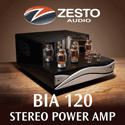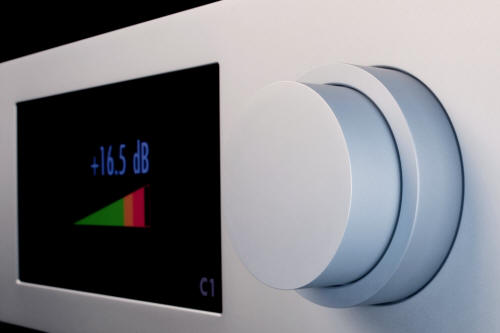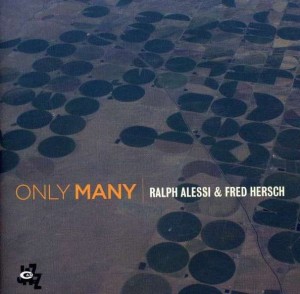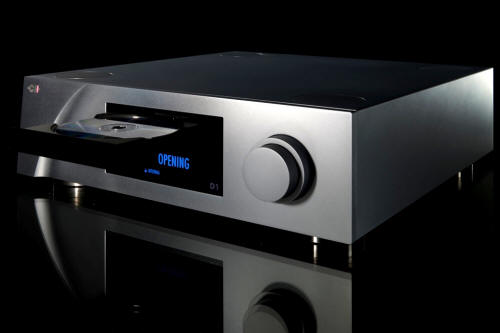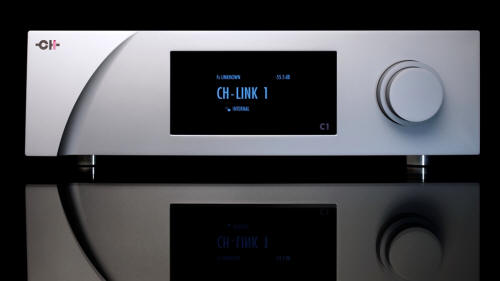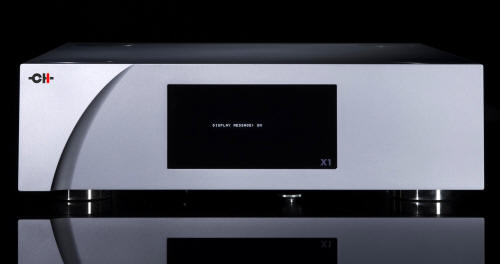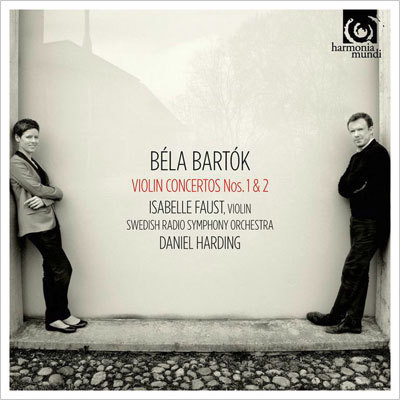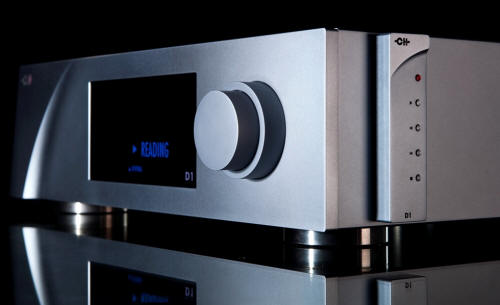|
|
You are reading the older HTML site
Positive
Feedback ISSUE 74
ch precision C1, D1, and X1 - The Ultimate Digital Source? as reviewed by Marshall Nack
C1 Preamp/DAC "I know who that is—that's the trumpet/piano duo we heard at the Kitano Hotel that night." Spot on, George. The date was the release party for Only Many with Fred Hersch and Ralph Alessi (Cam Jazz CAM 5048). We both bought CDs, which they autographed for us.
Now we were in my living room, listening attentively to Hersch's solo on track 3, San Francisco Holiday. It was uncanny: I felt I was witnessing two brains at work. How could his left and right hands be so independent, laying down opposing meters, improvising contrasting melodies? It was highly entertaining. What was it like? Sonically, rather mediocre. There is a noticeably artificial reverb on Alessi's trumpet; the recording venue is not convincing as a real space. But that's not why I purchased the CD. I bought it with the hope it would evoke that night's performance and, in that regard, it was a markedly successful advance from the last time I played this disc—it was more like two giant steps—and the difference was the C1 Preamp/DAC and D1 Disc Transport/Player from CH Precision which we had recently installed.
D1 loading Let's continue with the Mozart Requiem, a new, reference quality SACD from Linn (LINN 449), and compare the CH D1 as a transport feeding the C1 DAC to my reference Accuphase DP-600. (I know that's hardly fair!)
Sonic Sculpting On the Audio Report Card, the Accuphase gets good, if not excellent, grades, but that's not what sold me on it. Compared to the run-of-the-mill CD players out there, it brings to the table an acoustic timbral palette that skirts the synthetic, manufactured quality of most. It balances solid-state circuitry with the kind of musical qualities found in tubed CD players like the Ayon CD-5s or the E.A.R .Acute—without exhibiting their excesses. Somebody in the Accuphase design lab must be a connoisseur of acoustic classical music (or had consulted with one). It is one of the few SACD players that I enjoy listening to. When I swap over to the CH, it's like getting an updated prescription from the optometrist. The stage snaps into focus and becomes graphically partitioned into precise 3D blocks. Everything is totally resolved. There is no ambiguity. Instruments are disentangled from each other and occupy their own space with enhanced weight and body. They stay put, never venturing outside their borders. Want to follow inner voices? Sure. Pick one—any one. While not hard edged, there's less blending and the spaces between them are left profoundly empty—the CH does not manufacture "air" or bloom to fill the gaps. This is the C1 DAC with the "No Filter" option selected: the source stood naked before us. (I'll get into filter options in detail shortly.) It's very similar to the sculptural quality I described in the CH A1 Mono-amp review, only now CH Precision is doing it at the front-end.
CH A1 Monoblock The CH somehow breathes life into every instrument, even supporting ones. And this vitality is present all the time, even at the low end of the dynamic spectrum. You know what usually happens during low-level passages: the sound becomes grey, dynamics compress, and you sit, waiting for the next big dynamic swing to carry you along. The Power Dynamic I love the way the CH grows into a crescendo. Instrumental sections swell incrementally, maintaining their finely delineated placement and, as they hit fff, nothing changes, except they are more solid and vivid than ever. The huge, virtual soundstage has swollen to proportions that push on the room boundaries, almost too big to fit within its confines. Fortissimos are not just louder, they are more potent. There's such a boost to dynamic range and impact you might think the CH is exaggerating dynamic transitions. Actually, it's the other way around. The CH fulfills those contrasts, while other gear compresses them. Jeez, I knew amps were capable of this—I never suspected a front-end could boost up performance in the same way. All of this is audio candy, like mainlining aural endorphins. It brings back fond memories of when I was running 845 tube monoblocks. That power tube is known for its rambunctious upper bass/lower mid energy and fullness. Audiophiles just love crescendos with realistic impact. Timbres As I mentioned, I was originally sold on the Accuphase timbres, but time passes. I began to notice similarities from instrument to instrument, from CD to CD. Each had that analog-like timbre, a "cut from the same cloth" holistic quality and lengthy decay. This suggested to me the machine was doing some tweaking, comparing the source to an internal template and adjusting it. Ever since I learned there's a DSP chip inside the box that's been a lurking suspicion. If true, the Accuphase is imposing a fairly heavy footprint, albeit a very lovely one, over the signal.
While the CH is not bloomy or beautiful and doesn't have lengthy decays, it nails the gestalt of the thing. The church acoustic of the Mozart Requiem has been gloriously recreated. Timbre, tone and instrumental balances are correct, allowing even easier positive ID as each one sounds unique. How can that be? I believe the CH doesn't do template matching and hence imparts less of its own signature—it is more honest. This implies that the CH has a wide palette at its disposal to create unique timbres. Exploring Digital Filters Midway through the audition, it came to my attention that the C1 DAC supports a menu of digital filter options. Furthermore, DSD and PCM could be set independently. Until now I had been listening to SACDs with the C1 set to "No Filter." When I moved it to "Minimum Phase," the inter-image spaces filled in to a degree. The sound became more liquid—most audiophiles would judge it more analog-like. On "Linear P. sharp," I heard some treble rounding, a softening of image boundaries and more filling in. Decays moderately lengthened. The "Linear P. apodising" filter was like Linear P. sharp, only more-so. Lynn and I had a definite preference for the Minimum Phase filter. Both Linear P. options introduced unwanted processing effects and important low-level info was lost. The No Filter option we judged too raw. My rig at this time consisted of the CH front-end→Trinity Preamp→Ypsilon Aelius monoblocks. Later, when the Audionet MAX monoblocks replaced the Ypsilon Aelius amps, we had to revisit the filters. Now the Minimum Phase seemed smooth and processed. We came away preferring the No Filter setting. I don't see any pattern in these results, but that's how it played out. It's great to have a choice, because experimenting with the filters allows you to eek out the most perfect tuning. One size definitely does not fit all. While I haven't done an actual survey, it appears to me the majority of consumer DACs use a filter, only they don't talk about it. Some give you a choice: a few let you opt out with a No Filter option. Listening in the Foreground The Accuphase produces a big, blended sound, located mostly around the plane of the speakers. Almost everything sounds good, feels good, too. You can listen in the background and go about your business. It is not intrusive. It does not demand you pay attention. With the CH, that's impossible. The crisp articulation, the separation of musical lines, and especially the dynamic life it imparts, demand engagement. Even though the CH stage is located at about the same place, it is hard to put it in the background. Associated Equipment For most of the audition I was running the CH digital into the Ypsilon PST 100 Preamp and Aelius monoblocks. Teleportation occurred often with this incredible line up. That old stereo magic took me out of the actual and placed me in a passable simulacrum of the live venue. The myth is this recreates the live event—but who knows? This system will stand as an enduring high point.
Contrast this with the teleportation created by SET gear, like Audio Note Japan. ANJ places you up close and personal the musicians, they are playing in your room, just for you. Magical, yes—realistic, less so. Introducing the Trinity Preamp—Live in the Studio Then I swapped to K-S balanced cable and inserted my Trinity Preamp. Wow! It didn't have the sweet, flowing line and effortless naturalism, but what a glorious sound! The Trinity brought unprecedented control and power, and provided a third kind of transport. Now I felt I was present in the recording studio. This lineup—CH Precision digital→Trinity Preamp→Aelius amps—had a live-in-the-studio type of sound. Ah, the fun and games of Hi-Fi. The Aelius added a slight softening, which served to temper the incisiveness of the upstream gear. The result was super refined and totally sympatico. Even with this lineup, there is still some latent manufactured aspect—I fear that's inescapable with digital—but it came as close to transcending digititus as ever. X1 External Power Supply—the Open Window I recently reviewed the Audionet DNP, a Preamp/DAC that came with an external power supply upgrade (available at extra cost). Interestingly, CH offers an external power supply upgrade for both D1 & C1.
The CH X1 is a full size chassis dedicated to one component. (It can be fitted for two, on request.) Is this a trend? In both cases, it made quite a difference.
In the first movement of Bela Bartok's Violin Concerto No.1 with Isabelle Faust (HMC 902146),there is a morendo (see note below) which seemed to stretch out forever, before slipping into silence. That is awfully difficult to pull off, musically speaking, and it wasn't there before we installed an X1fitted to power both the C1 and D1. At least it wasn't as noticeable as it is now. *Morendo is a dynamic marking in classical music notation which literally means dying. The note/chord gets gradually softer until it fades into silence. This is contrasted with a diminuendo, in which a phrase simply decreases in volume, relative to what came before. I know the CH does not lengthen decays—this was newly dredged up in the source. How did that come about? I don't think it's related to the noise floor, that spurious, ever-present, hash. You know, the white noise you hear if you put your ear close to the speaker, especially the tweeter. I haven't been aware of the noise floor in ages; whatever remains of it is certainly inaudible at the listening position. The X1 lets you hear deeply into the recording. In general, instruments are more pure and analog-like, with a heightened 3-D volume and no ambiguity as to when a note ends. They are easier to "see." The X1 accomplishes this with no shift towards lean and mean. Orchestral Tutti At the other extreme, amidst all the confusion and layering of dense orchestration, Isabelle can be heard playing softly and continuously against the much louder orchestra. This is something I often can't hear even in the concert hall. Busy orchestral scores often mask the soloist. But, oddly, I could hear her just like I could hear the morendo. Let's put it this way: while it doesn't quite fulfill the proverbial open window, the opening widened appreciably. A Single Caveat The only caveat is that those vaunted qualities which place the music in the foreground are magnified when the X1 is put into play. It becomes even more dramatic. But not everyone cares for all that drama. Some listeners wanted less of the dynamic roller coaster, less "sitting on the edge of my seat" intensity. Cosmetics All three components come in the same chassis, rather large boxes for these purposes. (The A1 Amplifier is also in the same.) Esthetically speaking, the satiny aluminum chassis is a thing of industrial beauty. Fit-n-finish hit the highest Swiss industry standards, with softly squared-off corners, no visible screws, and silky action of the large control knobs to the right of the display window. The back panels are loaded with an unusual number of In/Out jacks, proprietary switches and a variety of Option Slots for the D1 and C1. (Extra functionality, at extra cost.)
C1 Option Slots The front-panel display window of the D1 and C1 is large and easy to read. It provides access to a sophisticated menu system. This is next-gen gear: the range of user selectable options is daunting. Even the color of the text in the display window can be personalized. Installation Make sure you allow enough burn-in time when you audition the CH Precision C1/D1. The quality will be obvious from the git-go—you'll hear that in a few notes—but early on it has a dry quality and images are a bit stiff and etched. Then, at about the two week marker, you'll flip the switch and do a double take—Whoa! What just happened? Just like that the stiffness and dryness evaporate. The D1 was used as a transport feeding the C1 for DAC purposes, a traditional two box CD/SACD front-end. The D1 can do this alone, but we wanted to shoot for the max and the C1 DAC has a better processor. (The C1 brings a host of additional functionality that I didn't have time to get into. Many people feel it is a state-of-the-art preamp.) A couple of things to note: - The D1 takes an unusually long time to load an SACD. - The D1 and C1 have separate, matching remotes with limited functionality. There is no universal remote.
D1 with remote I opted not to use the beautifully engineered, built-in spikes, mostly due to height limitations of my rack. Heat is a consideration with the C1, even more so with the X1. And, in truth, the sound is already so Hi-Res I had no desire for more. (Maybe I'll revisit this later.) Conclusion For this review, I focused on the CH Precision D1 as a transport feeding the C1 for DAC purposes, as a conventional two box CD/SACD front-end. Maybe it shouldn't have come as a surprise, but I found the D1/C1 shared many of the strong suits of the CH Precision A1 Amplifiers. In particular, the uncluttered, sculptural quality of the soundstage, the purity and vitality of instruments, and the way crescendos scale. We know amps impact these areas big time: Who would have thought a front-end could step them up in the same way? The D1/C1, especially with the X1 in line, did not behave like any digital I've encountered. Neutral, exciting, fast, tons of detail, yet musical in a way that is honest to the source, not gussied up with bloom and decay trails, it is not like the audio we grew up with. This kind of sound did not exist until now. As far as I'm concerned, CH Precision is at the forefront of digital technology. They are the leader of the pack. Marshall Nack
C1 Preamp/DAC
D1 Disc Player
X1
External Power Supply Manufacturer
CH
Precision Importer information
Audioarts
|






